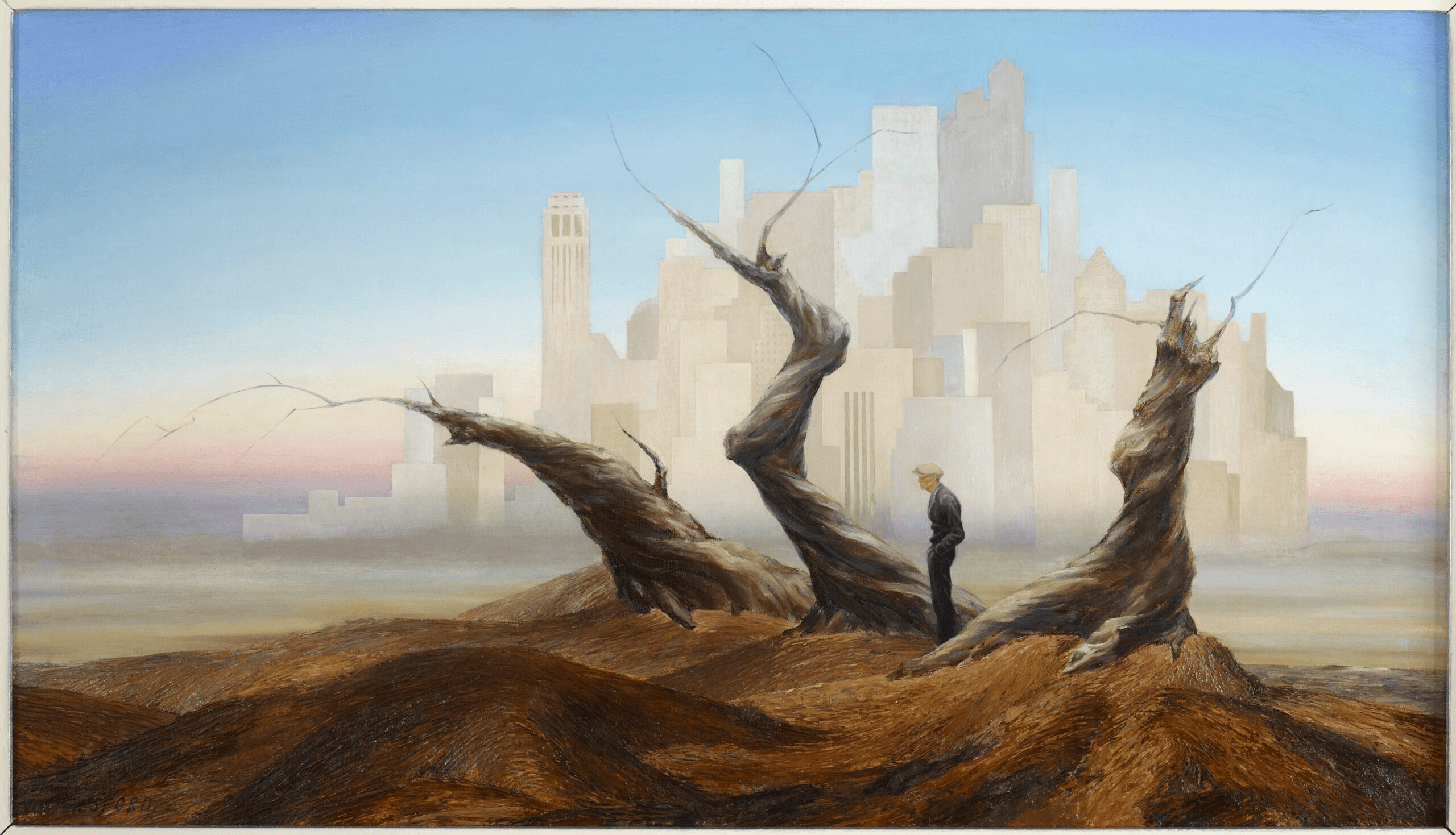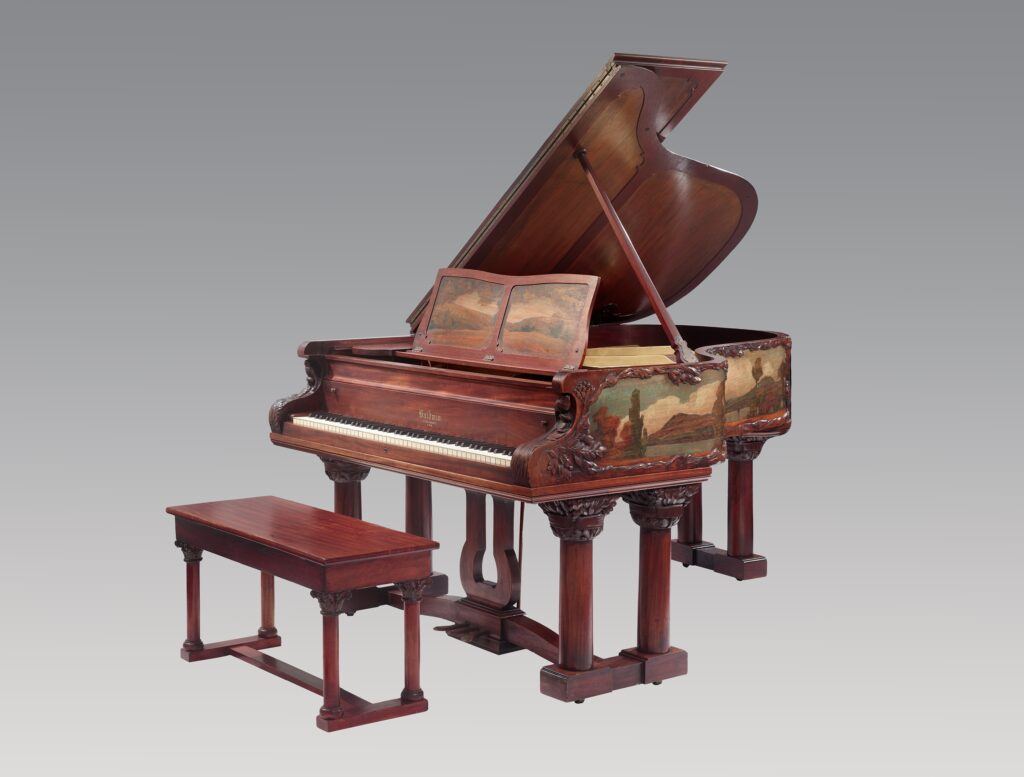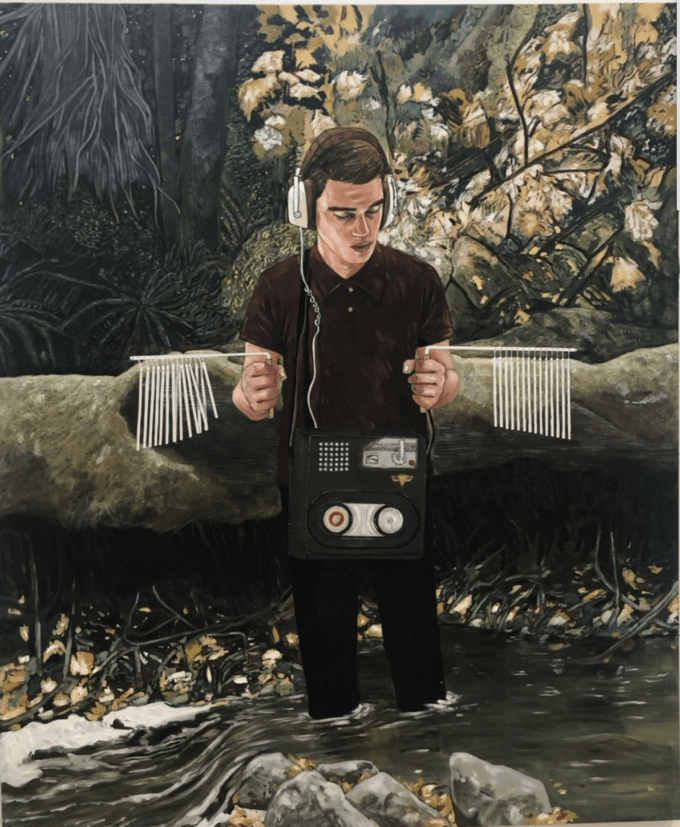

Virginia Berresford, The City, 1936. Pphoto: Wolfsonian-FIU.
Recent scientific predictions have Miami Beach, a slender barrier island just off the swampy Florida mainland, more than halfway underwater by mid-century. Chronically underestimating looming realities, climate scientists admit to being continually overtaken by increasingly catastrophic developments. One can assume that the white sands of Miami Beach and the stylish foyers of its famous art deco hotels will be swamped far earlier than expected.
The hotels and beaches can’t be moved, but the art can. Miami Beach has fashioned itself into a center for the stuff. For two decades the island has hosted Art Basel Miami Beach, a privately run fair that, at the most recent edition last December, brought together nearly 300 international galleries to the Miami Beach Convention Center.
Nostalgia is a powerful force in art, so perhaps rising seas will also buoy the market for Miami Beach’s aesthetic wares, even if they (the wares) will have to be shipped offshore or uphill. Paintings of Streamline Moderne facades seen across white sands and through palm trees could sell well, like Hudson Valley School paintings of vanished arcadian landscapes or still snowy Mount Rainier rising above the tidewater.
Higher ground will have to be found. After extending its global reach from Switzerland to Miami Beach, Art Basel has now added Hong Kong and Paris to its circuit. The top elevation in Basel is currently more than 500 meters above sea level.
Miami Beach is also rich in museums. Its most fascinating is the Wolfsonian. Though not answering the siren call of the contemporary, the Wolfsonian’s holdings and exhibitions attain a bracing, sometimes unsettling, contemporary relevance spurred by the art’s irresistible aesthetic appeal.
The founder, Mitchell Wolfson Jr., now in his mid-eighties, is a native of the island. His father was a media magnate, who became the first Jewish mayor of Miami Beach in 1943, though he resigned his post within a year to fight the Nazis on German soil.
Born in September of 1939, the same month that the Wehrmacht invaded Poland, the younger Wolfson became fascinated by art and design and began depositing his quickly accruing collections at the Washington Storage Company, a richly adorned warehouse two blocks from the beach. The facility had been constructed as a bastion against the elements that would safeguard the furniture, art, carpets, and jewelry of Miami’s wealthy seasonal residents. Built in the Mediterranean Revival style, the structure is itself a work of art and shames the corrugated ministorage units that now blight the American landscape.
By 1986 Wolfson’s hoard occupied 90% of the warehouse, so he decided simply to buy the whole place. In 1992 Wolfson oversaw the architectural renovation of the building and its conversion into a museum, and in 1996 he donated the building and its contents to Florida International University. The collection now runs to some 200,000 items spanning the years between 1885 to 1945; the holdings include 125,000 books held in a research library that welcomes scholars pursuing interesting projects. The art and design objects range in size from medals, to silver-plated bookends commemorating the building of the Hoover Dam, to a free-hanging spiral staircase removed from a demolished Pennsylvania mansion, to stylish 1930s sofas of walnut, brass, and leather formerly in the 1st– and 2nd-class waiting room of Milan’s central train station.
The elegance of those sofas—visitors are encouraged to sit on them—might at first distract one from the realization that that they are the products of Fascist Italy. Many works in the museum remind us, even warn us, that artistic talent and creativity can flourish under dark regimes.
A braille edition of Mein Kampf 1933 on display is both paradox and metaphor: intended for the disabled excluded from the master race, the book is also a literal embodiment of blindly following the Führer. Wolfson himself points out, however, that Hitler was temporarily blinded by mustard gas during World War I and may have approved of the publication for use by veterans who had permanently lost their sight.

Braille edition of Mein Kampf. Marburg, 1933. Photo: Wolfsonian-FIU.
In one of the current exhibitions, “The Big World: Alternative Landscapes of the Modern Era,” running until June 2nd, one surveys images of canals, bridges, factories, powerlines, smokestacks, railroads, freeways, and other urban-industrial encroachments depicted in paintings and other media, such as silver plates and textiles.
A painting of autobahn construction in the Third Reich hangs not far from one of New Deal dam-building in the American West. Both are part of the allied war on Nature.

Wilfried Schäflein, Autobahnbrücke (Autobahn Bridge), 1940. Photo: Wolfsonian-FIU.

Robert Oliver Engard, West Buttress, Grand Coulee Dam Construction, 1940. Photo: Wolfsonian-FIU.
Music figures in the Wolfsonian’s holdings: Tin Pan Alley song sheets with their colorful covers; cruise ship and Miami Beach hotel entertainment programs; instruments. In a another of the current exhibitions, “Silhouettes: Image and Word in the Harlem Renaissance,” running until June 23rd, one ponders the mournful, resilient blues lyrics of Langston Hughes paired with illustrations by Jacob Lawrence (One-Way Ticket, 1949); a lithograph by Mabel Dwight portrays a proud, wary Paul Robeson; photos by Carl Van Vlechten capture a pensive Ella Fitzgerald and a flamboyant Cab Calloway
The Landscape show’s first object is also its largest: a fabulously veneered Baldwin grand piano made in Cincinnati at the beginning of the 20th century. A collaboration between the painter Joseph Henry Gest and sculptor Clement J. Barnhorn, who carved the mahogany garlands and the capitals of the legs, the sumptuous instrument was first exhibited at the Louisiana Purchase Exposition—the World’s Fair of 1904. An alluring landscape of lakes, trees, gentle hills, distant mountains, and soft clouds encircles the instrument and adorns its music stand. No natives are seen, nor ravenous Donner partiers. Jefferson had purchased an idyll from Napoleon, one whose “settling” could be commemorated with civilized piano music emanating as if from the land itself.
The lone guard on that entire floor of the museum dozed in an alcove tucked to the side of the elevator. The slack security dared me to grab a few chords of “American the Beautiful” on the Baldwin, but decorum and silence prevailed.

American Art Piano, 1904. Photo: Wolfsonian FIU.
Tracing in reverse the trajectory of Art Basel from Old World to New, there is now a Wolfsonian Museum (the Wolfansia) in Genoa, Italy, also on the seaside.
A mile to the north of the Wolfsonian in Miami Beach is the Bass Art Museum. The entrance leads through the old 1930s Public Library with its graceful Art Deco façade that, inside, opens onto airy modern spaces. On the second of the two floors there is now a show called “The Conceptualists” with some thirty large canvases from painter Hernan Bas.
Born in 1978 in Miami, Bas commands an elegant, precise technique animated by endlessly inventive humor. There is an edge in his work that cuts through the laid-back, often melancholic mood of the pictures. The artfulness is almost diffidently virtuosic; the output unfathomably prolific; the “concepts” flirt simultaneously with irony and pathos, the trite and profound.
These are paintings to be hung on big white walls like in the Bass and in the many beachfront (for now) villas of this low-lying region’s rich collectors, though Bas’s work is also shown by galleries in London, Seoul, Hong Kong, Zurich, and Paris. The final painting hanging at the end of the gallery is the largest, measuring nine-by-seven feet: Conceptual artist #37 (he exclusively paints portraits of conceptual artists who have never existed). In its center stands the painter (as the label says, not a self-portrait) staring out at us from his studio. Behind him spreads a tour-de-force compendium of figures and motives seen in the other paintings previously encountered in the gallery: an infinite regression of make-believe.
Like the fantastical images he crafts, Bass’s labels are quietly hilarious, clever but not cloying. He makes fun of the stand-offishly generic avant-garde approach that affixes only a number to the artworks. To these Bas adds archly Escher-like commentary in parentheses.
Music and sound—from hobby rockets firing, to snowflakes falling, to prohibitions against singing posted in an moody absinthe bar—resound mutely in several of the paintings.
In Conceptual artist #30, vintage technology is forced by a head-phoned “artist” (also not a portrait; none of the paintings are) into ridiculous collaboration with the natural world. Tiny, meticulously calibrated dowsing rods hang like upside-down organ pipes from thin bars gripped in each of the young man’s fists. The sticks’ hollow clatterings are being recorded by a reel-to-reel tape deck strapped around his shoulders. The encumbered sound explorer is deep in his art and deep in the swamp, nearly up to his knees in the murky water. Needless to say, this nerd-of-nature-and-paranormality’s polo shirt has to be buttoned all the way up.

Conceptual artist #30 (sound-based, his Water Music is composed with the aid of modified dowsing rods), 2023. Acrylic on linen. 182 x 152 cm (6 x 5 ft). Courtesy the artist and Galerie Peter Kilchmann, Zurich/Paris.
.The dowsing rods perform a duet of contrasts. Those in his sway gently, those in his left are still and therefore unsounding. The varied tempo and turbulence of the waters below are exerting their mysteriously precise forces exactly as the techno-dowser expects them to.
Rather than listen to the riffling bayou with ears bared, this Conceptual artist stands in self-mediated solitude. He’ll never go digital. Analog is a real as he gets. The same might be said for the painting itself.
The meandering Everglades yield up a Water Music rather less grandiose than Handel’s. Only the Conceptual artist in the picture will ever hear it.
This image of art as alienation could not be more placidly surreal, its weirdness offering a slyly devastating commentary on the public loneliness of the ear-budded masses hustling and bustling far beyond the swamp.
Thankfully, in the fantastical world of this painting, the water in which the Conceptual artist stands won’t ever rise farther up his Conceptual pant legs.
The post Beach Art, Water Music appeared first on CounterPunch.org.
This post was originally published on CounterPunch.org.

